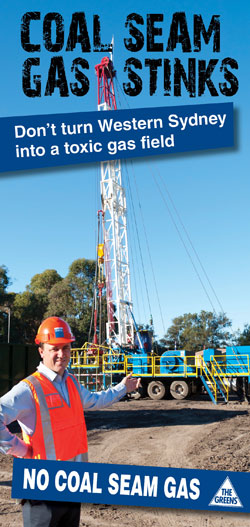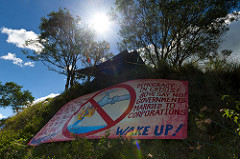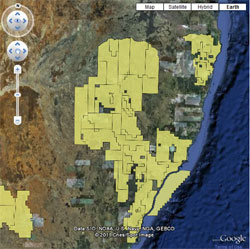MEDIA RELEASE 4 April 2014
The Greens NSW spokesperson on mining Jeremy Buckingham today expressed his dismay that the government’s centrepiece policy to protect groundwater, the Aquifer Interference policy, will not apply to the assessment of Santos’ 850 gas well project, despite admissions from Santos that there are risks to aquifers, a record of contamination incidents and the fact that it sits above a Great Artesian Basin recharge area.
Santos have lodged their Preliminary Environmental Assessment with the Department of Planning as the first stage of the assessment process. Page 29 says: “an aquifer interference approval would not be required for the proposed development” arguing that this is because the government has not made the appropriate ‘proclamation’.
“This is a catastrophic bungle by the O’Farrell Government. The Aquifer Interference policy is meant to be the centrepiece policy to protect groundwater from mining. That it does not apply to the largest coal seam gas project in the state is a complete farce,” said Greens MP Jeremy Buckingham.
“The Greens call for any assessment of the project to be halted until the government can rectify this bungle to ensure that the Aquifer Interference requirement is applied to the assessment of the Santos project.
“If this is an intentional oversight to help push through the Santos project, then the government has a lot of explaining to do. If it is a bungle, then the Water Minister should resign.
“The Preliminary Environmental Assessment admits that coal seam gas development may impact on groundwater quality and quantities, with risks that cross-contamination of aquifers can occur and there may be cumulative drawdown impacts and subsidence.
“A major concern about coal seam gas has always been its impact on water. This project cannot slip through a loop hole and put at risk local water resources and the Great Artesian Basin.
“Other concerns with the project include bushfire risks, the vague plans to deal with the massive amounts of salt and toxic waste water this project will create, as well as significant native vegetation clearing and industrialisation of the Pilliga forest and surrounding bushland,” he said.
A project brief sheet follows.
Contact: Max Phillips - 9230 2202 or 0419 444 916
The Preliminary Environmental Assessment document has been released by Santos for the Pilliga coal seam gas project.
http://www.santos.com/library/Narrabri%20Gas%20Project%20request%20for%20DGRs.pdf
The project will be 850 gas wells with an area of 98,000 hectares. It will include high voltage power lines hooked up to the state grid; an expansion of the already massive waste water facilities; in-field compressor stations; as well as a large gas treatment plant.
Major issues:
1) Claim they do not need to get an Aquifer Interference approval.
P.29 Although Santos admit “the project would encounter groundwater, and would, therefore, penetrate an aquifer” they claim that the government has not ‘proclaimed’ the Aquifer Interference provisions of the Water Management Act. “Accordingly, an aquifer interference approval would not be required for the proposed development.”
Aquifer interference approval was the O’Farrell Government’s major policy put in place to protect aquifers from damage from mining. It is the centrepiece of their policy response. The fact that the biggest coal seam gas project in NSW, that sits on top of a Great Artesian Basin recharge area, does not need to get an aquifer interference approval is a scandal.
2) Admission that project will likely damage groundwater.
P.39-40 Admit the project has the impact to damage groundwater through:
- Depressurisation
- Leakage through poorly constructed gas wells
- Changes to groundwater quality
- Cross-contamination of aquifers
- Cumulative drawdown impacts
- Subsidence
- Spills and leaks affecting shallow alluvial aquifers
- Changes to groundwater ecosystems
3) There is no clear plan for waste water or salt management.
The EIS is vague about how it will dispose of waste water, brine and the huge quantities of salt it will produce. It is highly likely that the salt will have to be buried as land fill. This will require a site of hundreds of hectares. Where will the salt be buried? P.14-15
A significant expansion of the waste water ponds will be required. These ponds are already 800 mega litres or 325 Olympic swimming pools in size.
4) The project is likely to be connected to the electricity grid and require high voltage transmission lines through a bushfire prone area. P.15-16
5) Admission that a fire at a gas well head could initiate a bush fire
Placing a major gas field in the middle of a highly bush fire prone forest has always been a major concern for local residents.
6) Santos admit there will only be 200 ongoing jobs.
P.41










